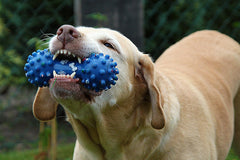
What is the average lifespan of a Great Dane? The answer to this question can be pretty surprising, as it ranges anywhere from 8 to 10 years of age. However, with proper care and attention, your Great Dane dog's lifespan may increase substantially. In addition, certain factors and symptoms to watch for extend your pup's life, such as maintaining a healthy weight and regular veterinarian care. Keep reading to learn more about caring for your Great Dane.
Reasons Why Great Danes Have a Short Lifespan

Unfortunately, the American Kennel Club reports the average lifespan of a Great Dane is from as young as six years to as old as twelve. None of which can offer comfort to their beloved human parents and family members. Scientists don't know why the large, fearless pups have such a short lifespan. However, they suspect it has to do with the breed's size.
The Great Dane is susceptible to several conditions, more than the average breed.
Bloat
The biggest health concern with the Great Dane is bloat. This ailment is often fatal. It occurs when the stomach twists and cuts off the blood supply. Once your dog is diagnosed with bloat once, it often returns. However, medical procedures are available to reduce the risk after the first bout of bloat.
Also known as gastric dilation-volvulus (GDV), it has several noticeable symptoms,
- Enlarged abdomen
- Restlessness
- Sore to the touch
- Retching
- Excess salivation
Treatment must be administered in less than two hours to prevent death. Care includes treating the dog for shock first and then deflating the stomach in surgery. The veterinarian also removes any damaged portion of the stomach wall.
Cardiomyopathy
Cardiomyopathy is an enlarged heart. The condition disrupts the dog's heartbeat. It may also lead to congestive heart failure. Your dog might not present with any symptoms. The only way to detect it without symptoms or incident is through electrocardiography (ECG). If the Great Dane develops congestive heart failure, there will be noticeable symptoms, including coughing from fluid buildup in the lungs.
Joint & Bone Disease
Joint and bone health problems are common with any large breed. The most common for the Great Dane are hip dysplasia and osteoarthritis. These conditions slowly eat away at your dog's quality of life. However, there are ways to boost their quality of life and help them live longer with the condition while still enjoying every day. For example, your veterinarian may suggest certain supplements and prescribe anti-inflammatory medications. Physical therapy and joint fluid modifiers can also potentially help your Great Dane.
Thyroid Problems
Thyroid conditions, such as autoimmune thyroiditis, may cause hypothyroidism. Treatment is necessary to keep pets with these ailments healthy. Your veterinarian can monitor the disease and regulate it with medication. Testing involves a simple blood test. Watch for symptoms of hypothyroidism, such as hair loss on the truck, back of rear legs and tail, a dull coat, flaky skin, and decreased appetite. Also, your dog might gain weight despite eating less. Muscle loss might be noticeable, and as it progresses, sluggishness is possible.
A Brief Description & History of the Great Dane Dog

The Great Dane is a large and tall dog, standing at 32 inches at the shoulder. When standing on their hind legs, many are taller than some of their owners. Despite the Great Dane's size, they're elegant and graceful in all movements. The breed's not limited in color or pattern. However, the most common is a black and white patchwork, which is also called a harlequin design.
Although the Great Dane's name translates to Big Danish in French, there's no known story for how the dog breed became associated with Denmark. The Great Dane dog is a German breed, called Deutsche dog or German dog in the Central European country.
In the breed's early history, German nobles used them to hunt wild boars. Shortly after and still to this day, the Great Dane is a great family protector.
How to Increase a Great Dane's Lifespan

Several tips are available to encourage wellness and longevity. If you adopt from a breeder, make sure to get a health history of the breeding lines. Watch for genetic problems, such as cardiovascular issues and hip dysplasia. These can shorten their lifespan.
Encourage a healthy diet that meets all the nutritional needs of the large breed. Pay close attention to portion control. Great Dane's that grow too quickly are more likely to develop musculoskeletal diseases. These include osteochondrosis and dysplasia.
Diet goes hand-in-hand with fitness. Obesity can shave even more years from the Great Dane's lifespan. Regular veterinary care can help you track your dog's weight and catch problems early. The earlier the diagnosis, the better the prognosis.
Conclusion
The Great Dane has a short lifespan. However, owners may be able to extend their pet's longevity through exceptional care. First, it's essential to know the signs of bloat, which is the number one condition that can end a Great Dane's life. Regular veterinary checkups, a nutritious diet, portion control, and exercise are all vital to keeping your Great Dane happy and healthy.
How long do Great Danes Live?
How tall is a Great Dane?
What were Great Danes bred for?
Related Posts:
- Guaranteed Tips To Improve Pet Life
- The Top 7 Most Affectionate Dog Breeds
- Do Large or Smaller Breeds Live Longer?




